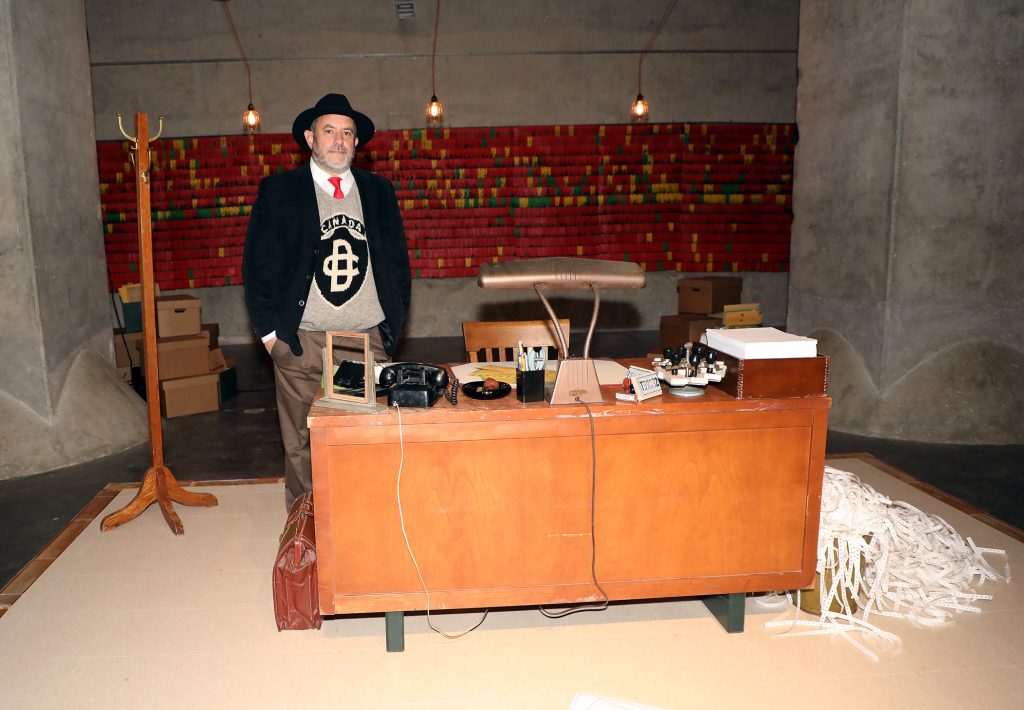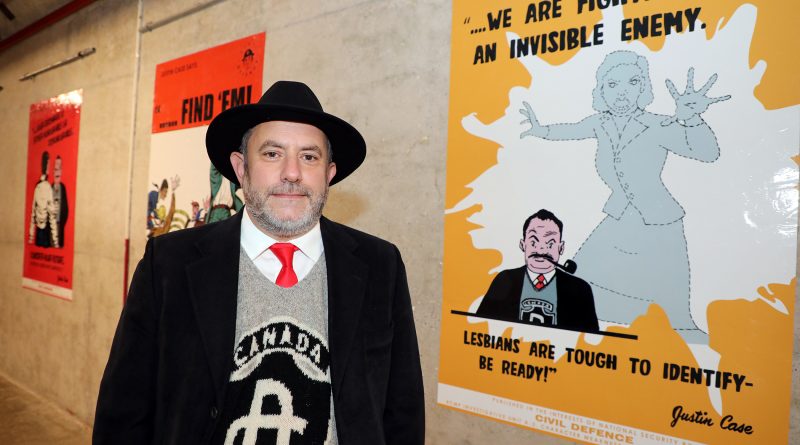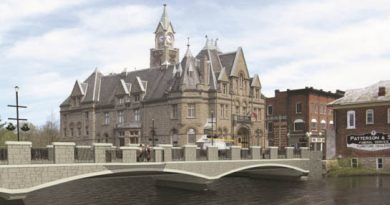Diefenbunker artist captures LGBT purge
By Jake Davies - West Carleton Online
CARP – During the Diefenbunker Cold War Museum vernissage for 2022 Artist-in-Residence Christos Pantieras, visitors got to view his take on military propaganda while learning about the LGBT Purge of Canadian military history.
Last Thursday (Oct. 13) evening Pantieras debuted his work to invited friends, family and museum guests in the exhibition Justin Case: The Enemy Within.
Through a series of reinvented propaganda posters and a multi-layered installation in the depths of the Diefenbunker, namely the outside hall and the Bank of Canada vault in the museum, Pantieras addresses the hidden and ‘underground’ nature of homosexuality in Canada during the Cold War.
The LGBT Purge began in the 1950s during the Cold War and continued up until the mid-1990s. Canadian civil servants, RCMP employees, and Canadian Armed Forces personnel who were perceived or discovered to be 2SLGTBQ+ faced systematic discrimination and dismissal. Drawing from the intersection of this history and from his personal experience, Pantieras has reimagined Justin Case, a character originally created by Civil Defence Canada to promote preparedness and safety, as a decorated RCMP Investigator and closeted gay man who turns double agent.
West Carleton Online spoke to Pantieras at the vernissage about his experience as the 2022 artist-in-residence and how his work grew out of the experience.

“The idea for the show is centred around this comic character, or Canadian mascot, called Justin Case, I found him on the Diefenbunker website and he was in these 1950s posters that gave people tips to be safe for civil defence,” Pantieras said. “I was really drawn to the character and I thought what can I do with him? What’s his backstory? Long story short, because you can see the final work, I decided to focus on him for the Diefenbunker component from my research here, but frame the entire show around the LGTB Purge. That was basically a time when gays and lesbians in particular, were looked at as security threats, as they referred to them as having character weakness. They were considered susceptible to blackmail. They were investigated, they were followed, they were really mistreated. And when they were alleged, or suspected or discovered to be gay or lesbian, they were either fired or given no choice but to quit.”
Pantieras turned Justin Case in to a living, breathing three-dimensional person.
There were some long-term consequences to that to some people,” he said. “So, what I’m doing, I’m framing the exhibition around the LGTB Purge and the Cold War era through the eyes of Justin Case. I wrote his backstory. I authored him as an individual who is working for the RCMP; he’s participating in the purge; he’s seeking out gay and lesbian and queer people; but he is also secretly, a deeply closeted gay man himself. So, he circumvents those efforts by destroying evidence, looking to save people as well. He’s a very conflicted individual. So, not only is the exhibition about the purge, it’s also about self-acceptance, and the inner-struggle and inner-conflict as well.”
The exhibition starts in the long hall leading to the vault. Pantieras’ redesigned propaganda posters line both sides of the wall. Inside the vault Pantieras has created Justin Case’s office with an era-specific desk and office supplies. There is an overflowing bin of shredded documents beside the desk. There is an audio playing, 22-minutes long if you listen from start to finish, of Justin Case’s inner dialogue as he wrestles with the decisions he makes.
“The posters are about ‘watch out for the gays and lesbians,’ Justin Case is depicted in that role,” Pantieras says of his reproductions. “When you walk in the larger space, I have created Justin Case’s office, you actually see and hear his inner struggle. His personal struggle and his job. There is this narrative that reveals who he truly is inside. You see these tags on the walls that represent the 9,000 people that are estimated to have been affected by the LGTB Purge over those years.”
Even Pantieras, for the night of the vernissage anyway, is wearing the suit Justin Case wears.
“The posters do have a sinister undertone to them, but they are playful, they do show Justin in a manner that is him just going about his duty, being very loyal to what his purpose and job is,” Pantieras said. “The posters show that side, and then when you walk in to the office you get this whole other side where you really hear about himself and his struggle.”
Pantieras says the project was personally important to him.
“I’m a gay man myself, but I did not experience the purge, that was before my time, I only found out about it later in life,” he said. “Prime Minister Justin Trudeau did give a formal apology in 2017 to the queer community. There is a monument that is being built. I thought it was a timely moment to really focus on this. Being a part of the community, I felt connected to this, even though it wasn’t something that happened to me, it was something I felt I should know more about. I really enjoyed doing the research. Kind of mortified at some points about how people were treated. The project just seemed to grow and grow as I did more research. The project you see now, was not the original proposal. It’s evolved.”
Part of the residency involves working at the museum and using the museum’s resources.
“The Diefenbunker staff have been very gracious and welcoming, I’ve been able to go in to their archives and look at all these things, I even thought the way the archive room was set up was very interesting,” he said.
Pantieras’ residency isn’t the first time the Ottawa-based artist has been to the Diefenbunker. The art community in Ottawa is a small one, and Pantieras has attended a couple of the Diefenbunker residency vernissages.
“That kind of put the artist-in-residence program on my radar,” he said. “Something I definitely wanted to apply to and hopefully get to experience. I can’t believe it’s up. A year ago, at this time Justin Case wasn’t even an idea. It was nothing to me because I hadn’t even written the proposal. So, it’s been great. It’s gone really fast. It’s odd to me this is now out in the world for people to experience. Even though I knew what I was going to do how it evolved, I didn’t really hit the ground until July.”
Pantieras says financial funding from the City of Ottawa, the Ontario Arts Council, and the Canada Council for the Arts helped make the project possible.
Christos Pantieras’ exhibition Justin Case: The Enemy Within will be on display at the Diefenbunker Cold War Museum until Feb. 15, 2023.











